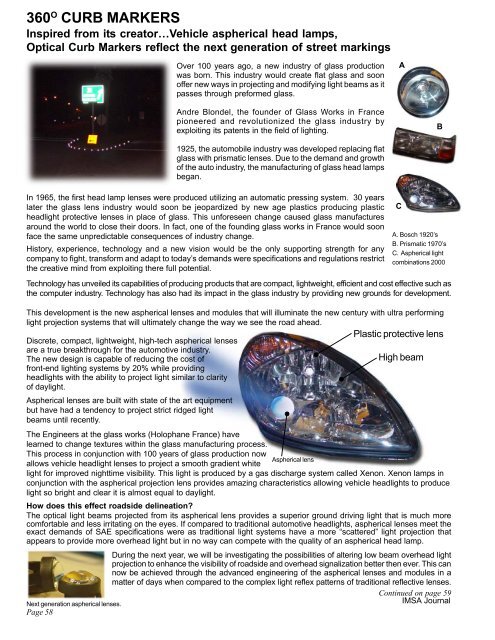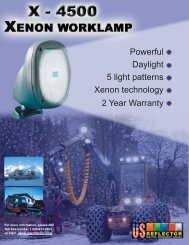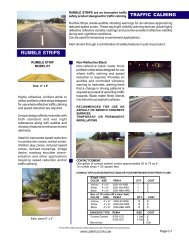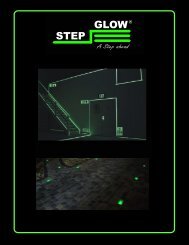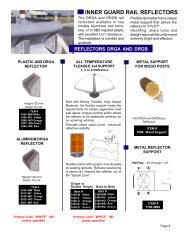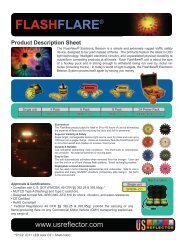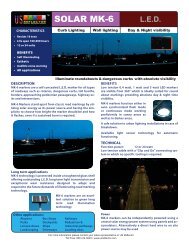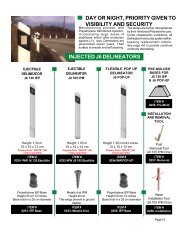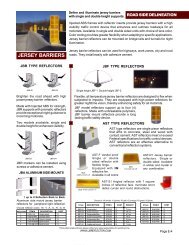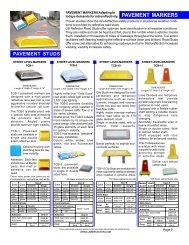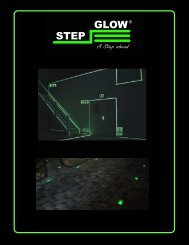Ware image page.p65 - US Reflector
Ware image page.p65 - US Reflector
Ware image page.p65 - US Reflector
- No tags were found...
You also want an ePaper? Increase the reach of your titles
YUMPU automatically turns print PDFs into web optimized ePapers that Google loves.
360 O CURB MARKERS<br />
Inspired from its creator…Vehicle aspherical head lamps,<br />
Optical Curb Markers reflect the next generation of street markings<br />
Over 100 years ago, a new industry of glass production<br />
was born. This industry would create flat glass and soon<br />
offer new ways in projecting and modifying light beams as it<br />
passes through preformed glass.<br />
A<br />
Andre Blondel, the founder of Glass Works in France<br />
pioneered and revolutionized the glass industry by<br />
exploiting its patents in the field of lighting.<br />
B<br />
1925, the automobile industry was developed replacing flat<br />
glass with prismatic lenses. Due to the demand and growth<br />
of the auto industry, the manufacturing of glass head lamps<br />
began.<br />
In 1965, the first head lamp lenses were produced utilizing an automatic pressing system. 30 years<br />
later the glass lens industry would soon be jeopardized by new age plastics producing plastic<br />
headlight protective lenses in place of glass. This unforeseen change caused glass manufactures<br />
around the world to close their doors. In fact, one of the founding glass works in France would soon<br />
face the same unpredictable consequences of industry change.<br />
History, experience, technology and a new vision would be the only supporting strength for any<br />
company to fight, transform and adapt to today’s demands were specifications and regulations restrict<br />
the creative mind from exploiting there full potential.<br />
C<br />
A. Bosch 1920’s<br />
B. Prismatic 1970’s<br />
C. Aspherical light<br />
combinations 2000<br />
Technology has unveiled its capabilities of producing products that are compact, lightweight, efficient and cost effective such as<br />
the computer industry. Technology has also had its impact in the glass industry by providing new grounds for development.<br />
This development is the new aspherical lenses and modules that will illuminate the new century with ultra performing<br />
light projection systems that will ultimately change the way we see the road ahead.<br />
Plastic protective lens<br />
Discrete, compact, lightweight, high-tech aspherical lenses<br />
are a true breakthrough for the automotive industry.<br />
The new design is capable of reducing the cost of<br />
High beam<br />
front-end lighting systems by 20% while providing<br />
headlights with the ability to project light similar to clarity<br />
of daylight.<br />
Aspherical lenses are built with state of the art equipment<br />
but have had a tendency to project strict ridged light<br />
beams until recently.<br />
The Engineers at the glass works (Holophane France) have<br />
learned to change textures within the glass manufacturing process.<br />
This process in conjunction with 100 years of glass production now<br />
Aspherical lens<br />
allows vehicle headlight lenses to project a smooth gradient white<br />
light for improved nighttime visibility. This light is produced by a gas discharge system called Xenon. Xenon lamps in<br />
conjunction with the aspherical projection lens provides amazing characteristics allowing vehicle headlights to produce<br />
light so bright and clear it is almost equal to daylight.<br />
How does this effect roadside delineation<br />
The optical light beams projected from its aspherical lens provides a superior ground driving light that is much more<br />
comfortable and less irritating on the eyes. If compared to traditional automotive headlights, aspherical lenses meet the<br />
exact demands of SAE specifications were as traditional light systems have a more “scattered” light projection that<br />
appears to provide more overhead light but in no way can compete with the quality of an aspherical head lamp.<br />
During the next year, we will be investigating the possibilities of altering low beam overhead light<br />
projection to enhance the visibility of roadside and overhead signalization better then ever. This can<br />
now be achieved through the advanced engineering of the aspherical lenses and modules in a<br />
matter of days when compared to the complex light reflex patterns of traditional reflective lenses.<br />
Next generation aspherical lenses.<br />
Page 58<br />
Continued on <strong>page</strong> 59<br />
IMSA Journal


